Car Maintenance for Beginners: 10 Essential Tips for Success 2025
Why Car Maintenance for Beginners is Your Best Investment
Car maintenance for beginners doesn’t have to be scary or expensive. In fact, learning basic car care can save you thousands of dollars and keep you safer on the road.
Here’s what every new car owner needs to know:
- Check fluids monthly – oil, coolant, brake fluid, and washer fluid
- Monitor tire pressure – at least once per month and before long trips
- Replace air filter – every 30,000-45,000 miles for better fuel economy
- Change oil regularly – every 3,000-10,000 miles depending on your car
- Inspect lights and wipers – replace when dim or streaking
- Follow your owner’s manual – it contains your car’s specific maintenance schedule
Why does this matter? Routine maintenance like oil changes and tire rotations can help you avoid costly repairs and roadside breakdowns. Plus, keeping detailed service records can boost your car’s resale value when it’s time to sell.
You don’t need to be mechanic to take excellent care of your car. Simple tasks like checking your oil with a dipstick or using a tire pressure gauge take just minutes but can prevent major problems.
The bottom line: A few minutes of weekly checks can significantly extend your car’s lifespan while keeping you and your family safe on the road.
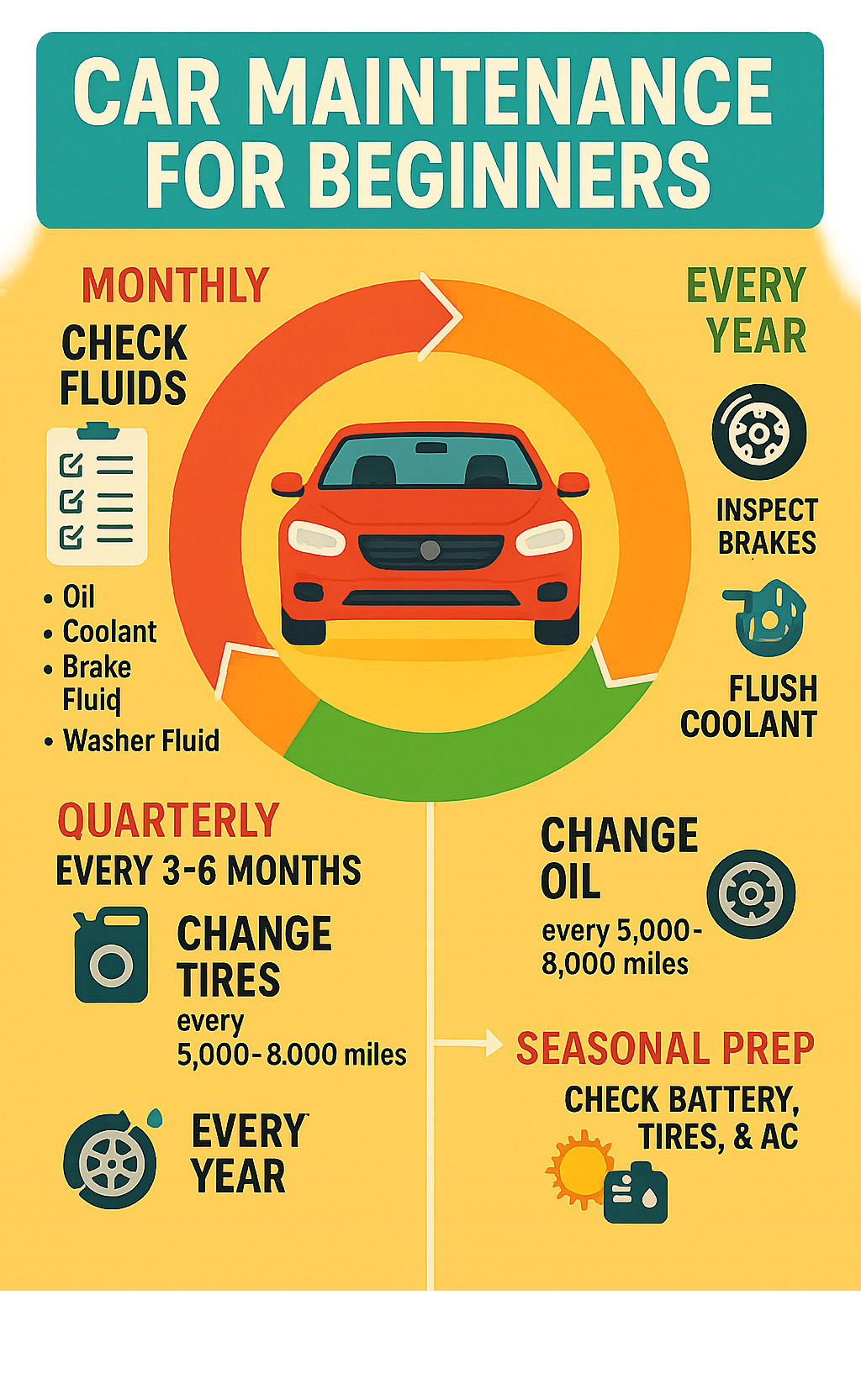
Why Every Driver Should Learn the Basics
Learning car maintenance for beginners empowers you to take control of your vehicle’s health. When you understand how your car works, you can spot problems early and avoid getting stranded on the side of the road.
Reliability is the biggest benefit. Regular maintenance ensures your car starts every morning and gets you where you need to go. As one mechanic put it, “You know how your car drives better than anyone else” – and that knowledge helps you catch issues before they become expensive repairs.
Resale value is another huge advantage. Well-maintained service records can boost your car’s value when it’s time to sell or trade in. Having detailed documentation shows potential buyers that you’ve taken care of the vehicle properly.
The confidence you’ll gain is priceless. Instead of feeling helpless when your check engine light comes on, you’ll know how to diagnose basic issues and communicate effectively with mechanics when professional help is needed.
Car Maintenance for Beginners: Safety & Starter Toolkit
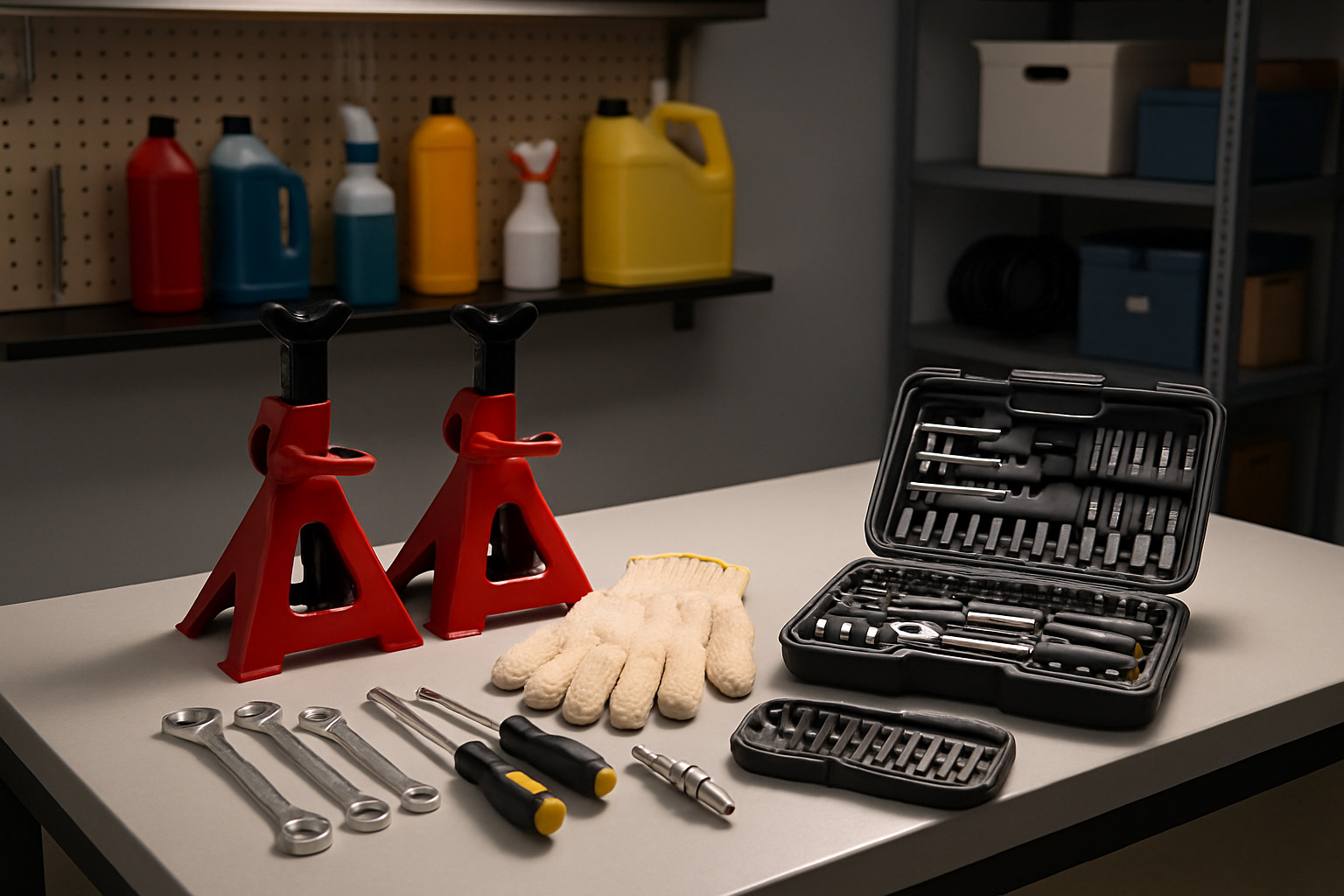
Before we dive into specific maintenance tasks, let’s talk about staying safe. Automobiles are big and heavy – following proper safety procedures is absolutely critical for car maintenance for beginners.
Safety Rules 101 – car maintenance for beginners
Always disconnect the battery when working on electrical components. This prevents accidental shorts and protects both you and your car’s computer systems.
Let the engine cool before checking fluids or working under the hood. Hot engines can cause serious burns, and removing a radiator cap from a hot engine can result in scalding coolant spray.
Work on level ground whenever possible. This ensures accurate fluid readings and prevents your car from rolling unexpectedly.
Wear proper clothing – avoid loose jewelry, baggy sleeves, or anything that could get caught in moving parts. One mechanic we know of lost fingers in a fan belt accident because he wasn’t following basic safety rules.
Use eye protection when working with fluids or compressed air. A simple pair of safety glasses can prevent serious injury.
Build Your DIY Toolkit
You don’t need a professional garage to maintain your car, but having the right tools makes everything easier and safer. Here’s what we recommend for beginners:
Essential tools:
- Socket set with ratchet handles
- Combination wrenches (metric and standard)
- Pliers (needle-nose and standard)
- Breaker bar for stubborn bolts
- Portable tire inflator
- Digital tire pressure gauge
- Funnel set for adding fluids
- Jack and jack stands (never rely on just a jack)
- Torque wrench for proper bolt tightening
- OBD-II scanner for reading engine codes
Safety equipment:
- Safety glasses
- Work gloves
- Spill kit (or plain kitty litter – it’s the same as commercial “Oil Dri”)
- First aid kit
For more detailed tool recommendations, check out our guide on essential tools every car enthusiast should have.
| Service Type | Average Cost | Pros | Cons |
|---|---|---|---|
| Dealership | $69-$105 (oil change) | Certified technicians, OEM parts, warranty protection | Higher labor rates, longer wait times |
| Independent Shop | $64-$98 (oil change) | Lower costs, personalized service, local relationships | Variable quality, may use aftermarket parts |
Using Your Owner’s Manual Like a Pro
Your owner’s manual isn’t just for finding the radio controls – it’s your car’s personal maintenance bible. This book contains everything you need to know about your specific vehicle.
Service schedule: Your manual lists exactly when to change oil, rotate tires, replace filters, and perform major services. Modern vehicles using synthetic oil can go up to 10,000 miles between oil changes, but your manual will tell you the exact interval for your car.
Fluid specifications: Not all oil is created equal. Your manual specifies the exact viscosity (like 5W-30) and type (conventional, synthetic blend, or full synthetic) your engine needs. Using the wrong fluid can void your warranty.
Lifting points: If you need to jack up your car, your manual shows the safe lifting points. Using the wrong spots can damage your vehicle’s frame or body panels.
Fluids, Filters & Battery: The Lifeblood of Your Car
Think of your car’s fluids as its circulatory system – they keep everything running smoothly and prevent costly damage. Let’s break down each fluid and why it matters.
How to Check & Top Off Each Fluid
Engine Oil is your engine’s lifeblood. It lubricates moving parts, acts as a debris sealant, cools the engine, and prevents corrosion. Here’s how to check it:
- Park on level ground and turn off the engine
- Wait 5-10 minutes for oil to settle
- Remove the dipstick and wipe it clean
- Reinsert the dipstick fully, then remove it again
- Check the oil level between the “MIN” and “MAX” marks
- If below the “ADD” mark, add oil gradually through the filler cap
Coolant prevents your engine from overheating and freezing. Check the level in the translucent overflow tank when the engine is cold – never remove the radiator cap when hot. The coolant should be between the “MIN” and “MAX” lines. If it’s low, add a 50/50 mixture of coolant and distilled water.
Brake Fluid is critical for stopping power. Locate the brake fluid reservoir (usually near the back of the engine bay) and check that fluid is between the high and low marks. The fluid should be clear or light yellow – if it’s dark or contaminated, have it flushed by a professional.
Transmission Fluid keeps your transmission running smoothly. Some cars have a dipstick for checking transmission fluid, while others require professional service. If you have a dipstick, check it with the engine running and transmission warm.
Power Steering Fluid makes steering effortless. Check the reservoir level and top off if needed. Some newer cars have electric power steering that doesn’t use fluid.
Windshield Washer Fluid keeps your windshield clean. This is the easiest fluid to check and refill – just pop the hood, find the reservoir (usually marked with a windshield symbol), and top it off.
Air & Cabin Filters – Quick Swaps
Engine Air Filter prevents dirt and debris from entering your engine. A clogged filter reduces fuel economy and performance. Here’s the “back-light test”: remove the filter and hold it up to a light source. If you can’t see light through it, it’s time for a replacement. Most filters need changing every 30,000-45,000 miles, but check yours annually.
Cabin Air Filter keeps your car’s interior air clean and your HVAC system healthy. This filter is usually located behind the glove box or under the dashboard. Replace it every 15,000-30,000 miles or when airflow from your vents decreases noticeably.
According to Consumer Reports research on car care basics, regular filter maintenance can significantly improve both engine performance and interior air quality.
Battery Health Made Easy
Your car’s battery typically lasts 3-5 years, but performance should be checked twice a year starting when it’s three years old. A fully charged battery should read 12.6 volts or higher. At 12.4 volts, it’s about 75% charged. Below 12 volts, your car may not start reliably.
Cleaning battery terminals prevents corrosion and ensures good electrical connections:
- Disconnect the negative cable first, then positive
- Mix 1 tablespoon of baking soda with 1 cup of water
- Scrub terminals with this solution using an old toothbrush
- Rinse with clean water and dry thoroughly
- Apply a thin layer of petroleum jelly to prevent future corrosion
- Reconnect positive first, then negative
Tires, Lights & Dash Warnings: Staying Safe on the Road
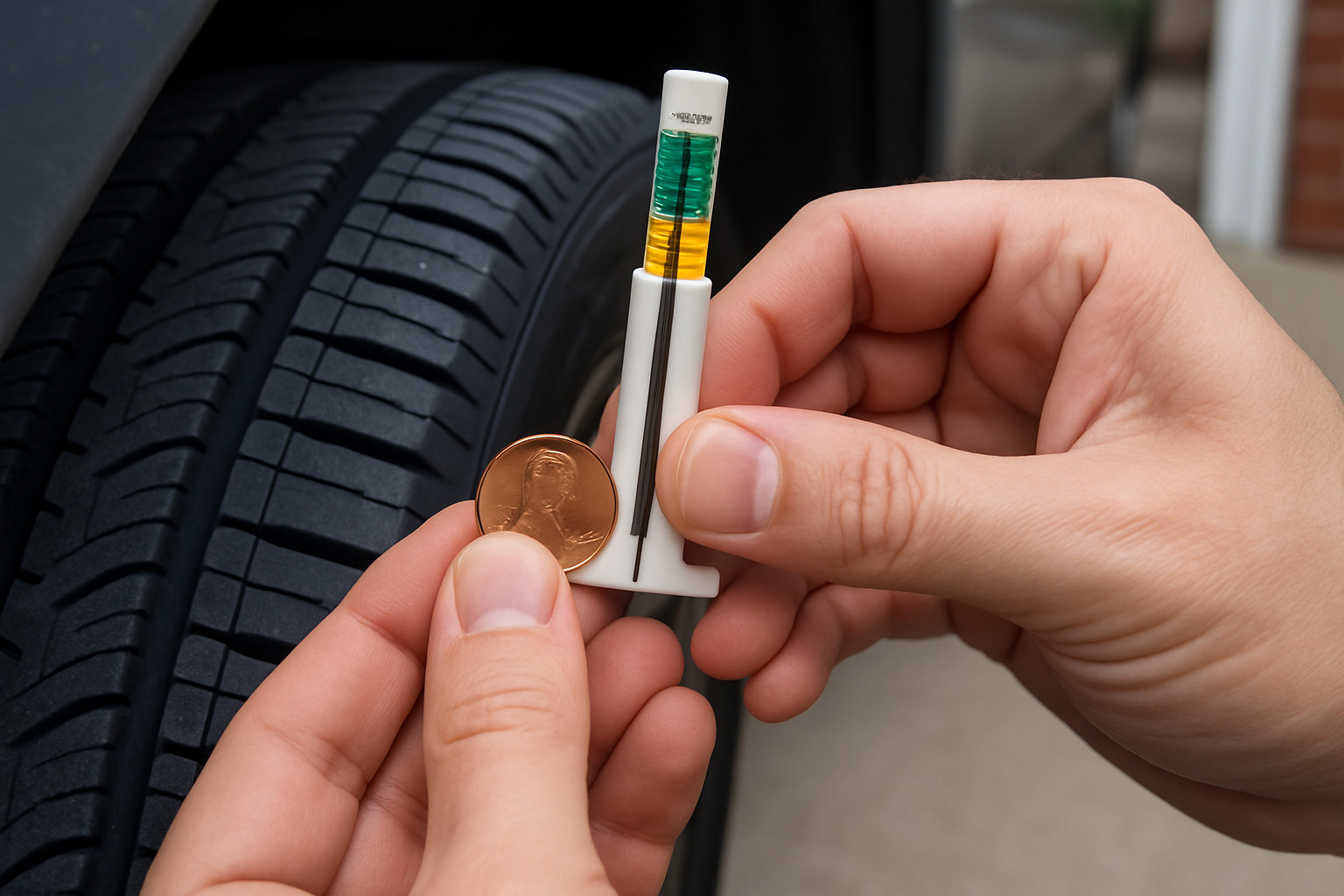
Your tires are your car’s only contact with the road, making them critical for safety. Your car’s tire pressure monitoring system (TPMS) will alert you when pressure drops below safe levels, but regular manual checks are still important.
Tire TLC — car maintenance for beginners
Tire Pressure should be checked at least once a month and before long trips. Use a reliable tire pressure gauge – we prefer digital gauges with illuminated readouts. Check pressure when tires are cold (before driving) for the most accurate reading. The correct pressure is listed on a sticker inside your driver’s door jamb, not on the tire sidewall.
Tread Depth determines how well your tires grip the road. The legal minimum is 2/32 of an inch, but we recommend replacing tires before they reach this point. Use the penny test: insert a penny head-first into the tread. If you can see all of Lincoln’s head, it’s time for new tires. For more accuracy, use a tread depth gauge.
Tire Rotation should happen every 5,000-8,000 miles to ensure even wear. This simple maintenance task can significantly extend tire life and maintain proper alignment.
Spare Tire often gets forgotten, but it’s usually inflated to 60 PSI and should be checked monthly along with your regular tires.
For comprehensive tire safety information, AAA provides excellent resources on proper tire maintenance and safety practices.
See & Be Seen: Lights and Fuses
Headlights are one of your car’s most important safety features. They help you see and help others see you. Replacing a burned-out bulb is usually straightforward and takes less than 30 minutes.
Bulb Replacement varies by vehicle, but the general process is:
- Access the bulb from behind the headlight housing
- Disconnect the electrical connector
- Remove the old bulb (don’t touch the glass with your fingers)
- Install the new bulb and reconnect the wiring
Testing Lights is easy – walk around your car and check all lights, or back up to a wall to see your brake lights reflected. Enlist a friend to help test brake lights and turn signals.
Fuses protect your car’s electrical systems. If a light or accessory stops working, check the fuse box first. Your owner’s manual shows which fuse controls what. Use a fuse puller to remove and inspect fuses – a blown fuse will have a broken wire inside.
Decoding Dashboard Warning Lights
Modern cars have dozens of warning lights, but here are the most important ones:
Check Engine Light can indicate anything from a loose gas cap to a serious engine problem. Don’t ignore it, but don’t panic either. An OBD-II scanner can help you read the diagnostic codes.
Battery Light means your charging system isn’t working properly. You may have a failing alternator or loose belt.
Oil Pressure Light is serious – stop driving immediately if this light comes on. Low oil pressure can destroy your engine.
Brake Warning Light could indicate low brake fluid, worn brake pads, or a problem with your brake system. Have it checked immediately.
ABS Light means your anti-lock brake system isn’t working, though your regular brakes should still function.
Routine Maintenance Roadmap & DIY How-Tos
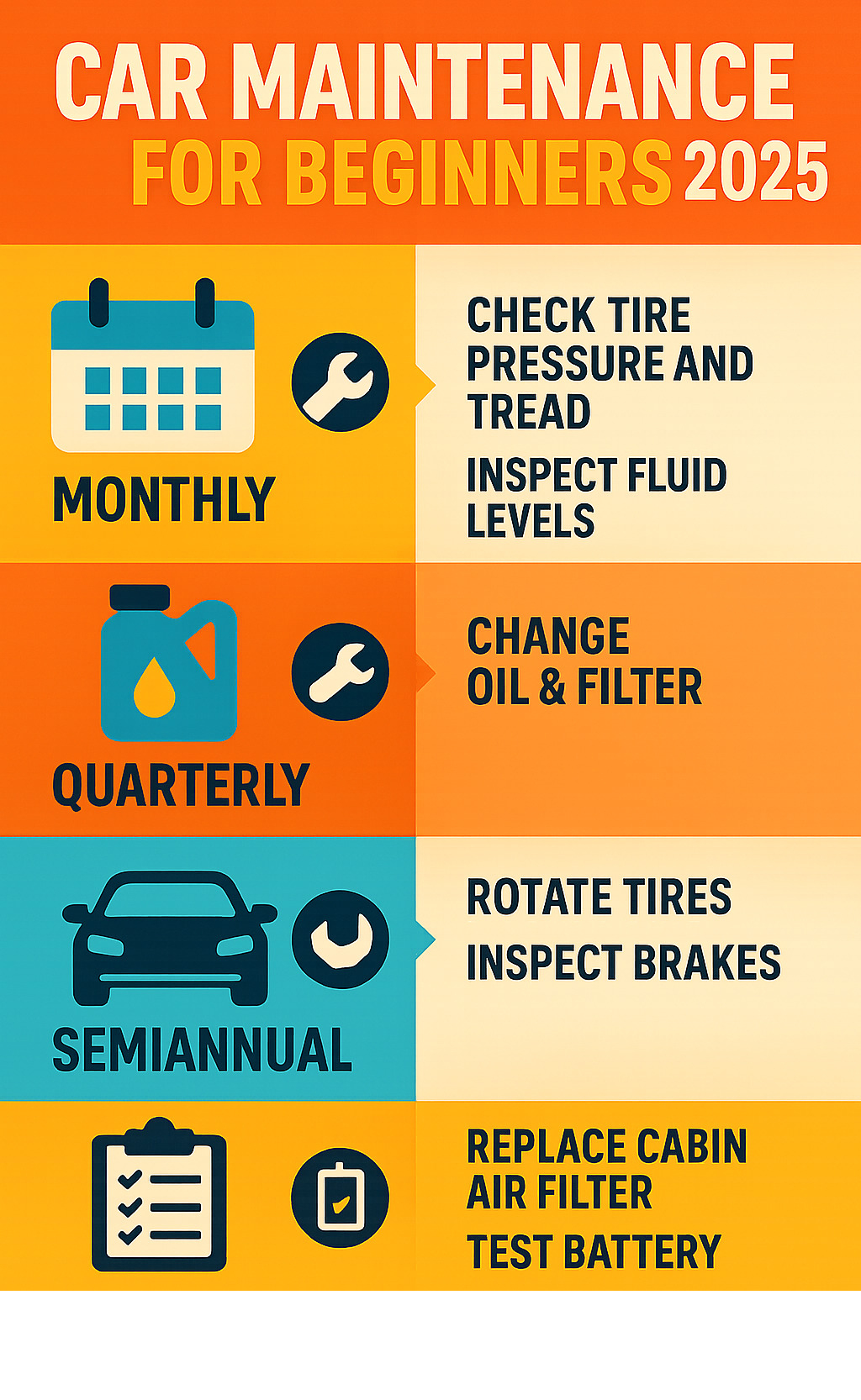
Creating a maintenance routine prevents small problems from becoming expensive repairs. Here’s how to organize your car care by time intervals:
Monthly Tasks:
- Check tire pressure and tread depth
- Inspect fluid levels (oil, coolant, brake, washer)
- Test lights and wipers
- Look for leaks under the car
Quarterly (Every 3 Months):
- Change oil and filter (for conventional oil)
- Rotate tires if due
- Check battery terminals
- Inspect belts and hoses
Semi-Annual (Every 6 Months):
- Replace windshield wipers
- Wax the vehicle exterior
- Check air filter condition
- Inspect brake pads
Annual Tasks:
- Replace engine air filter
- Check spark plugs (if accessible)
- Flush coolant system
- Inspect suspension components
At-Home Tasks You Can Master This Weekend
Oil Changes save money and help you understand your car better. While many modern cars can go 7,500-10,000 miles between changes, the old 3,000-mile rule still applies to severe driving conditions (frequent short trips, extreme temperatures, dusty conditions).
Tire Rotation is straightforward with the right tools. Most cars follow a simple front-to-back, back-to-front pattern. Check your owner’s manual for the specific pattern for your vehicle.
Wiper Replacement takes just minutes. Name-brand wipers are worth the extra cost for better rubber quality and UV protection. Follow the package instructions carefully to avoid damaging your windshield.
Air Filter Replacement is one of the easiest maintenance tasks. Pop the hood, locate the air filter housing, remove the old filter, and install the new one. Make sure it’s seated properly.
Visual Inspections catch problems early. Look for:
- Fluid leaks under the car
- Cracked or bulging hoses
- Frayed belts
- Worn wiper blades
- Dim or burned-out lights
When to Call the Pros
While we encourage DIY maintenance, some tasks require professional expertise:
Timing Belt Replacement is critical – if it breaks, it can cause thousands of dollars in engine damage. This job requires special tools and expertise.
Complex Diagnostics for persistent check engine lights or electrical problems often need professional scan tools and experience.
Warranty Items should be handled by qualified technicians to maintain your warranty coverage. However, using an independent shop for routine maintenance won’t void your warranty as long as you follow the manufacturer’s schedule.
Brake Work beyond fluid checks and visual inspections requires specialized tools and safety knowledge.
Transmission Service is complex and varies significantly between vehicles.
For more comprehensive maintenance guidance, visit our car maintenance tips page.
Frequently Asked Questions About Easy Car Care
How much does basic car maintenance cost per year?
Basic maintenance costs vary by vehicle age and type, but expect to spend $500-$1,200 annually on routine items like oil changes, tire rotations, and filter replacements. For example, oil changes range from $64-$105 depending on your location and oil type. Doing some tasks yourself can cut these costs significantly.
What are the first tools a beginner should buy?
Start with these essentials:
- Digital tire pressure gauge ($15-25)
- Basic socket set ($30-50)
- Funnel set for adding fluids ($10-15)
- Work gloves and safety glasses ($20)
- Portable tire inflator ($40-60)
These tools will handle 80% of basic maintenance tasks and pay for themselves quickly.
Can skipping maintenance void my warranty?
Yes, failing to follow preventative maintenance guidelines can void your vehicle’s warranty. However, you don’t have to use the dealership – following the manufacturer’s schedule at any qualified shop with proper documentation maintains your warranty coverage.
Conclusion
Car maintenance for beginners isn’t about becoming a mechanic overnight – it’s about building confidence, ensuring safety, and saving money. The simple tasks we’ve covered can prevent most roadside emergencies and extend your car’s life significantly.
Remember these key points:
- Start with safety and basic tools
- Follow your owner’s manual religiously
- Check fluids and tire pressure monthly
- Don’t ignore warning lights
- Know when to call professionals
At Car News 4 You, we believe that understanding your car improves your entire automotive experience. Whether you’re into luxury sports cars or practical daily drivers, basic maintenance knowledge makes you a more informed and confident car owner.
The intersection of car culture and practical knowledge is where real automotive enthusiasm begins. Start with these basics, and you’ll soon find that car maintenance can be both rewarding and enjoyable.
Check out our Ultimate Guide to Car Maintenance for 2025 for advanced tips and techniques that will take your car care skills to the next level.

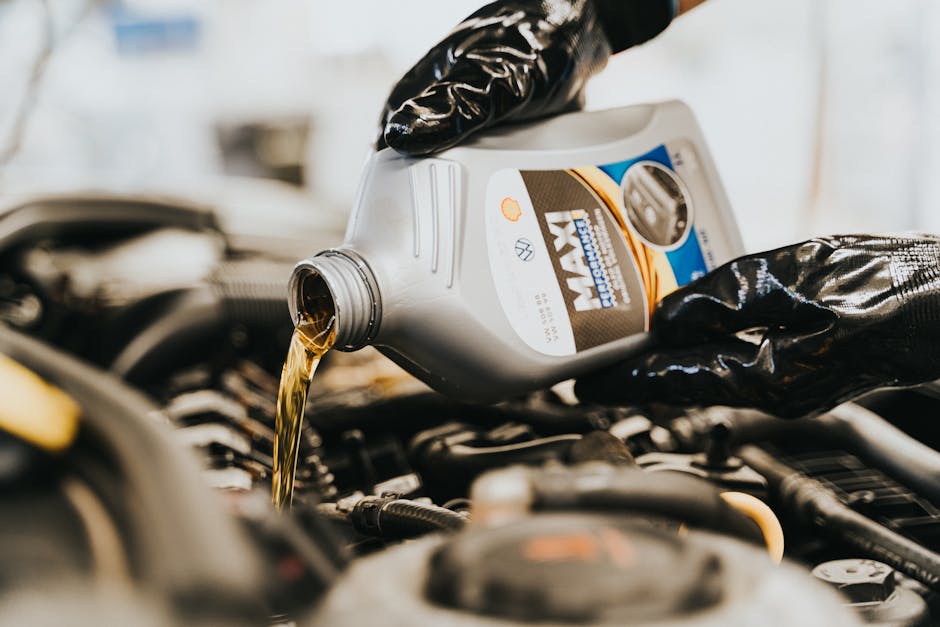






1 thought on “No Mechanic? No Problem! Easy Car Maintenance for Newbies”
Pingback: Oil Be There for You: Mastering the Art of Checking Your Car’s Oil - Car News 4 You
Comments are closed.